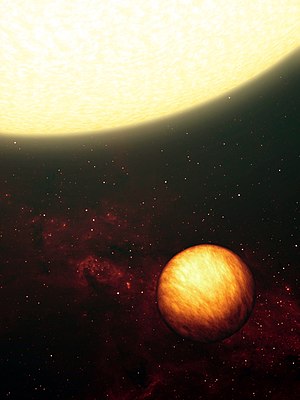仙女座υb
| 太阳系外行星 | 太阳系外行星列表 | |
|---|---|---|
 | ||
| 母恒星 | ||
| 母恒星 | 仙女座υ星 | |
| 星座 | 仙女座 | |
| 赤经 | (α) | 01h 36m 47.8s |
| 赤纬 | (δ) | +41° 24′ 20″ |
| 距离 | 43.9 ly (13.5 pc) | |
| 光谱类型 | F8V | |
| 轨道参数 | ||
| 半长轴 | (a) | 0.0595 ± 0.0034 AU |
| 轨道离心率 | (e) | 0.023 ± 0.018 |
| 公转周期 | (P) | 4.617113 ± 0.000082 d |
| 轨道倾角 | (i) | > 30° |
| 角距 | (θ) | 4.38 mas |
| 近星点的近心点经度 | (ω) | 63.4° |
| 近星点时间 | (T0) | 2,451,802.64 ± 0.71 JD |
| 半振幅 | (K) | 69.8 ± 1.5 m/s |
| 物理性质 | ||
| 质量 | (m) | 0.687 – 1.37 MJ |
| 半径 | (r) | 2.2[1] RJ |
| 温度 | (T) | ~150 to ~1800 K |
| 发现 | ||
| 发现时间 | 1996 | |
| 发现者 | Butler, Marcy et al. | |
| 发现方法 | 视向速度法 | |
| 发现地点 | 美国加州 | |
| 发表论文 | 出版 | |
| 其他名称 | ||
仙女座υ星Ab, 仙女座50b
| ||
仙女座υ星b,也被称为仙女座υ星Ab(以区别于其母星仙女座υ的伴星仙女座υ星B),是一颗位于仙女座,距离地球约44光年的系外行星。其母星仙女座υ是一颗太阳相似体。该行星的轨道周期大约为5地球日。1996年6月,杰佛瑞·马西和保罗·巴特勒发现该行星,它是首批被发现的热木星之一。仙女座υ星b还是仙女座υ行星系统中最靠近母星的行星。
发现
[编辑]和大多数已发现的系外行星一样,仙女座υ星b是通过探测其母星的视向速度的变化的方法得以发现的,而视向速度的变化则是需要测定仙女座υ光谱的多普勒频移。1997年1月,科学家对外公布了该发现成果,随之一同发布的还有巨蟹座55b和牧夫座τ星b的发现。[2]

如同第一颗在正常恒星周围发现的系外行星——飞马座51b一般,仙女座υ星b的轨道十分接近于其母星,该距离较之水星与太阳的距离更短。该行星的轨道周期为4.617地球日,其轨道半长轴为0.0595天文单位。[3]
由于视向速度法存在的局限性,科学家只能够依据该行星的轨道倾角测定其的质量下限,该数值为木星质量的68.7%。不过,最近科学家发现该行星的轨道倾角大于30°,这意味着其真实质量将介于0.687——1.37MJ之间。[4]科学家猜测该行星系统中的各行星可能并不处于同一平面上;仙女座υc和仙女座υd的相互倾角为35°。[5]
物理特性
[编辑]基于该行星质量较大的情况,科学家认为仙女座υ星b可能是一颗类木行星,其上并不存在固体表面。由于迄今只能间接地观测到该行星,所以还无法得知其半径和物质构成的情况。
斯皮策空间望远镜对该行星的温度进行了测定,发现其不同的两个半球的温差达到了1400℃:较冷的一个半球的温度大约在-20~230℃之间,较热的一个半球的温度达到了1400-1650℃。[6]有观点认为这种剧烈的温差是由于该行星已经处于潮汐锁定状态,它永远都以同一面面向其母星。
基于该行星的物质构成类似于木星,且其环境接近于化学平衡的假定,萨达斯基预测仙女座υ星b的上层大气中存在着由硅和铁构成的反射性云层。[7]不过在该行星上,该云层却起到了吸收恒星辐射的作用;在该云层和覆盖于地幔之上的高温、高压气体之间,存在着一层温度较低的气体平流层。[8]该行星最外层覆盖着一层暗色、不透明、高温的云层,由钒和铁的氧化物构成,但是也不排除类似索林之类的化合物的存在。
该行星四周不大可能存在大型的卫星,因为潮汐引力将会将其抛离轨道,或者在(相对于该行星演化的漫长时间的)一个很短的时间段内将其摧毁。[9]
该行星和飞马座51b均被认为是Planetpol直接成像计划的最佳候选对象。[10]
对其母星的影响
[编辑]仙女座υ星b可能是导致其母星日益增强的色球活动的主要因素之一。观测表明在仙女座υ球面上与行星轨道成169°交角的位置上存在着一个“热点”。这可能是恒星与行星磁场的交互作用的结果。类似的作用机制还包括猎犬座 RS变星联星系统内的相互作用以及木星与木卫一的相互作用。[11]
参见
[编辑]参考文献
[编辑]- ^ Upsilon Andromedae b. www.extrasolar.net. [2008-10-03]. (原始内容存档于2012-03-21).
- ^ Butler; et al. Three New 51 Pegasi-Type Planets. The Astrophysical Journal. 1997, 474 (2): L115–L118 [2009-08-17]. doi:10.1086/310444. (原始内容存档于2019-12-09).
- ^ Butler, R.; et al. Catalog of Nearby Exoplanets. The Astrophysical Journal. 2006, 646 (1): 505–522 [2009-08-17]. doi:10.1086/504701. (原始内容存档于2019-12-07). (web version (页面存档备份,存于互联网档案馆))
- ^ Benedict, George F.; McArthur, B. E.; Bean, J. L. The υ Andromedae Planetary System - Hubble Space Telescope Astrometry and High-precision Radial Velocities. Bulletin of the American Astronomical Society. 2007, 38: 185. Announced American Astronomical Society Meeting 210, #78.02
- ^ McArthur, B., Benedict, G. F., Bean, J., & Martioli, E. Planet Masses in the Upsilon Andromadae system determined with the HST Fine Guidance Sensors. American Astronomical Society Meeting Abstracts. 2007, 211.
- ^ Harrington, J; Hansen BM, Luszcz SH, Seager S, Deming D, Menou K, Cho JY, Richardson LJ. The phase-dependent infrared brightness of the extrasolar planet upsilon Andromedae b. Science. October 27, 2006, 314 (5799): 623–6 [2006-12-01]. PMID 17038587. doi:10.1126/science.1133904.
- ^ Sudarsky, D.; et al. Theoretical Spectra and Atmospheres of Extrasolar Giant Planets. The Astrophysical Journal. 2003, 588 (2): 1121 – 1148 [2009-08-17]. doi:10.1086/374331. (原始内容存档于2019-05-04).
- ^ Ivan Hubeny; Adam Burrows. Spectrum and atmosphere models of irradiated transiting extrasolar giant planets. 2008. arXiv:0807.3588v1
 [astro-ph].
[astro-ph].
- ^ Barnes, J., O'Brien, D. Stability of Satellites around Close-in Extrasolar Giant Planets. The Astrophysical Journal. 2002, 575 (2): 1087 – 1093 [2009-08-17]. doi:10.1086/341477. (原始内容存档于2018-10-28).
- ^ Lucas, P. W.; Hough, J. H.; Bailey, J. A.; Tamura, M.; Hirst, E.; Harrison, D. Planetpol polarimetry of the exoplanet systems 55 Cnc and tau Boo. 2007. arXiv:0807.2568v1
 [astro-ph].
[astro-ph].
- ^ Shkolnik; et al. Hot Jupiters and Hot Spots: The Short- and Long-term Chromospheric Activity on Stars with Giant Planets. The Astrophysical Journal. 2005, 622 (2): 1075–1090 [2009-08-17]. doi:10.1086/428037. (原始内容存档于2020-03-13).
Text is available under the CC BY-SA 4.0 license; additional terms may apply.
Images, videos and audio are available under their respective licenses.

